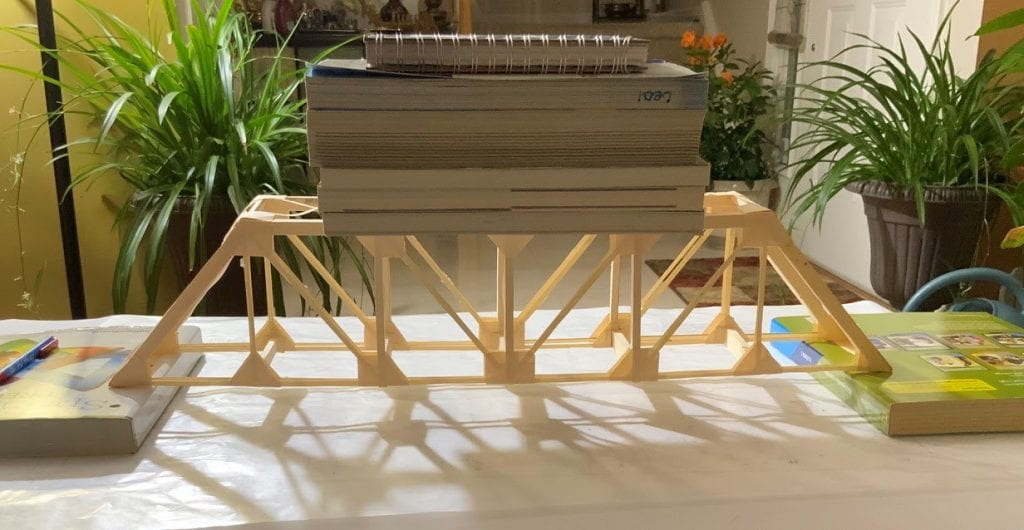A Virtual Semester at Dartmouth
Hello!
A month has gone by in my virtual, study away experience, and midterm season has just begun! This week has been a lot of studying for me, but during the weekend, I took a break and went on a mini hike with my family.
Dartmouth is on a quarter system, and this term, I’m taking two engineering courses and one elective. The terms are much shorter than at Amherst at about 10 weeks each and the classes are fast paced. In my solid mechanics class, we have been working on expanding our understanding about how Newton’s three laws of motion govern the properties and characteristics of structures around us. This class is notorious for its design project*, which has traditionally been to work in an engineering team to design and construct a model truss bridge. I was really happy to hear that this project was slightly modified to continue this year as well. Rather than building a bridge with the wood, our task is to build (primarily) with Manila paper folders.
During the beginning of the term, students received a package with all the supplies they need to build the bridge. This included the folders, wood glue, cutting utensils, and items that help in testing the bridge’s strength.
Each week, a portion of the project is due. Last week, the assignment was to build a pre-designed model as an introductory assignment. There was a lot of cutting, gluing, drying, and repeat, for this activity! This week’s assignment has included a lot of exploration through sketching – the professor specifically mentioned that these should be hand drawn, to give us a break from the screen 🙂
*Many of the engineering courses include a design component, which is similar to a laboratory session, but there is much less guidance and therefore more opportunities to explore ideas. In some classes, it is not uncommon for students to take their design idea to the next level, and obtain a patent for their work.

The Pratt truss is a common design found in many of the bridges in the world. As I was building, I couldn’t help feeling like an architect, slowly bringing the design to life.

I was surprised by the weight the bridges could hold (supposedly 10 kgs! Here I’ve tested 5kgs worth of books).
In my systems engineering class, the first three weeks included a crash course of differential equations and linear algebra (both classes were not prerequisites and I have not taken either, so it was a lot of new math for me!). Now, we have started to apply this math knowledge to create system models; mechanical systems with masses, levers, and (lots) of springs, electrical systems with capacitors, resistors, and the like. Labs are programming assignments using MATLAB, a language that is used throughout the engineering department. I came into the class without too much experience working with MATLAB, but because it is used so frequently, I have been able to get comfortable with it fairly quickly.
It has been challenging to meet other students while being remote, especially as a new student. Many of the courses have been implementing new additions to the virtual classroom to make it easier to collaborate with other students. All of my classes have been about 50 students each; in Systems, more than half of the students are Dual Degree students from other liberal arts institutions. This is nice because it is a space in which the professor understands that everyone is coming from different backgrounds and the course is put in such a way to accommodate that. The class utilizes a flipped classroom set up; we are assigned mini lecture videos to watch on our own time and during class, we break up into small groups to work on practice problems (similar to the discussion sections that Amherst STEM classes have). With this classroom environment, it has been possible to see other student faces and get to know the professors and teaching assistants (which can be undergrads, but are usually graduate students).
In solid mechanics, there are only three other dual degrees and classes are held in the more traditional lecture format. However, I think the design project aspect of this class will offer a good opportunity to work with other students. I chose my team last week, and as the term continues, we will be meeting frequently to discuss, design, build, and test a bridge we will develop together.
As a biochemistry and biophysics major, it has been a unique experience taking so many math and physics courses in one term. I’ve really enjoyed exploring another perspective in STEM and applying knowledge through the design projects and labs.
Until next time!
Amritha
